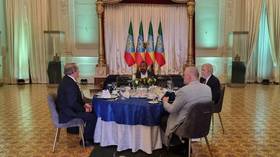Southern Russia mourns terror attack victims
May 28 was an official day of mourning in the Stavropol region in the south of Russia, where Wednesday's deadly terror strike claimed the lives of eight people and injured 40 others.
Three people who were involved in the terror attack have been arrested by the police so far, Interfax news agency reported.
A source in the local law enforcement told the agency that police also identified the Ingush woman who planted the device at the entrance to the Stavropol concert hall. The woman is currently wanted, the source said.
At the same time, according to Itar-Tass, law enforcement agencies of Ingushetia disprove information that those involved in the terror attack in Stavropol were detained in the republic.
“Our law enforcement authorities do not confirm such information,” the Ingush president’s press secretary told Echo Moskvy radio. “Somebody is trying hard to find the ‘Ingush trace’ in this terror attack,” added a source in Interior Ministry of the Republic of Ingushetia.
A bomb went off at 18:45 Moscow time (14:45 GMT) in the center of the city, outside the Culture and Sport Palace, where a concert was due to take place.
Preliminary data from the investigation suggests that it was a homemade device camouflaged as a small juice box which was triggered by either remote control or a timer.
In addition, the bomb was designed to cause as much damage as possible as it was inside a container filled with metal shrapnel.
Four people were killed on the spot and the number of fatalities later rose to seven.
A criminal investigation has been launched on charges of terrorism, murder and illegal circulation of explosives.
“We are working on establishing the identity of those behind the attack,” said Vladimir Markin, spokesman for the Prosecutor's Office Investigative Committee. “Investigators have questioned more than 60 eyewitnesses. We have completed the identification of those who were killed. We are also examining objects taken from the scene of the explosion.”
Flags in the region are at half-mast and several funerals of those killed have already taken place.
Wednesday’s blast in Stavropol comes in the wake of a chain of terrorist attacks in Russia, both in the Caucasus and in Moscow.
Stavropol lies close to the volatile Caucasus region, but has rarely been the target of terror strikes in recent years. The region’s governor has called the incident an unprecedented act of provocation designed to destabilize the region.
Families of those killed will get about $22,000 in compensation each. People who suffered grave injuries will get about $9,500, while those with light injuries will receive about $5,000.
Aleksey Pankin, a columnist for the Moscow Times newspaper, believes that investigators are looking into two versions – a terrorist act by Islamic extremists, or by local nationalist extremists.
“I suppose both versions are plausible. It seems to me at the first impression that the terrorist attack by the North Caucasian bandits is more plausible because it is kind of their way of doing things,” he said.
Nikolay Petrov from the Carnegie Moscow Center said that what is going on now is not only an escalation of terrorist attacks in the region, but an expansion of the region where previous attacks have taken place.











